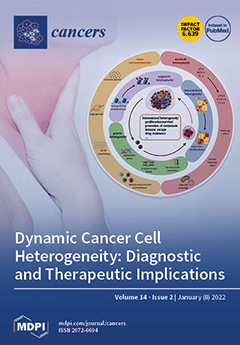Liquid biopsy-based tests emerge progressively as an important tool for cancer diagnostics and management. Currently, researchers focus on a single biomarker type and one tumor entity. This study aimed to create a multi-analyte liquid biopsy test for the simultaneous detection of several solid cancers. For this purpose, we analyzed cell-free DNA (cfDNA) mutations and methylation, as well as circulating miRNAs (miRNAs) in plasma samples from 97 patients with cancer (20 bladder, 9 brain, 30 breast, 28 colorectal, 29 lung, 19 ovarian, 12 pancreas, 27 prostate, 23 stomach) and 15 healthy controls via real-time qPCR. Androgen receptor p.H875Y mutation (
AR) was detected for the first time in bladder, lung, stomach, ovarian, brain, and pancreas cancer, all together in 51.3% of all cancer samples and in none of the healthy controls. A discriminant function model, comprising cfDNA mutations (COSM10758, COSM18561), cfDNA methylation markers (
MLH1,
MDR1,
GATA5,
SFN) and miRNAs (miR-17-5p, miR-20a-5p, miR-21-5p, miR-26a-5p, miR-27a-3p, miR-29c-3p, miR-92a-3p, miR-101-3p, miR-133a-3p, miR-148b-3p, miR-155-5p, miR-195-5p) could further classify healthy and tumor samples with 95.4% accuracy, 97.9% sensitivity, 80% specificity. This multi-analyte liquid biopsy-based test may help improve the simultaneous detection of several cancer types and underlines the importance of combining genetic and epigenetic biomarkers.
Full article






